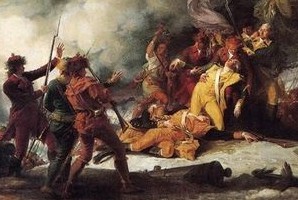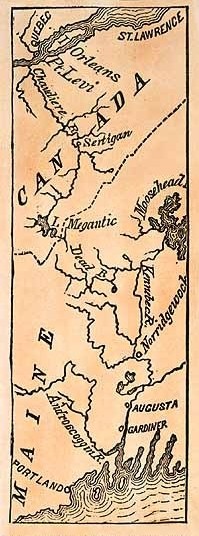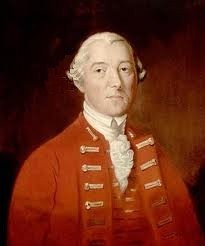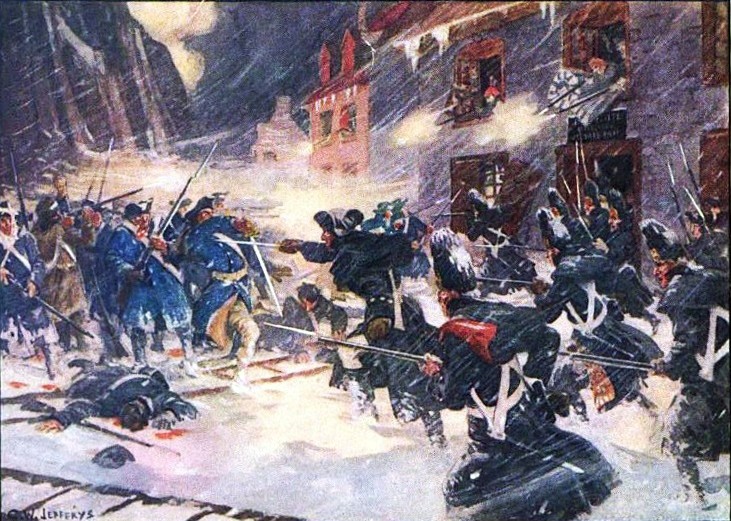~ The Battle for Canada ~
December 8th 1775 to June 7th 1776

|
When the British became bottled up in Boston, Loyalist recruitment particularly in the Mohawk Valley started producing significant numbers while at
the same time comparable numbers of pro-American Canadians were crossing the border into New York. So conscious of the threat a counter-revolutionary Loyalist
stronghold to the north would pose, Gen. Washington considered his options, deciding firstly to invite Canada to send delegates to their continental congress
in Philadelphia and sent 2000 letters to that effect. But Nova Scotia showed the least of all inclination to oppose acts of the British
parliament and French Canadians thought New England's rebels were a terrible and violent lot, so the letters were probably used as toilet paper. Rebuffed Washington then planned an invasion and sanctioned a two pronged attack, one led by Richard Montgomery approaching from Ticonderoga to first attack Montreal with 2400 men and then join the other 1100 men led by Benedict Arnold travelling up through Maine to attack Quebec.
When Arnold was patched up he only had around 500 men left who were running short of food, so he used these men to both steal from local Canadian ‘Tories’ and seek out pro-American Canadians to recruit, using their usual lies and false promises, this resulted in a hundred or so coming forward, enough to put the city under siege again, threating Carleton’s survival.
Her path then cleared, Royal Navy frigate HMS Surprise also arrived and raked Arnold’s besieging men with grapeshot, which so decimated them they could barely manage
to stagger away. Carleton’s men then raced out chasing them for miles inflicting even more casualties, capturing their cannon and much needed baggage. In a similar state the remaining rebels retreated, relinquishing Montreal and other taken forts while having to carry approx. 2000 sick and wounded with them. Arnold commanded a effective rear-guard throughout the summer and although constantly attacked, vindictively burnt down the town of Skenesborough and any homes they came upon, while searching for ‘Tories’. But at Valour Island he was caught and most of his boats were destroyed along with most of the main body of men, which meant that by the time they reached Crown Point at the south end of Lake Champlain there were only 200 of them left, finally returning to where they had started at Ticonderoga. With the rebels virtually destroyed and winter again approaching Carleton disengaged and returned to Canada. Frustrated Washington then tried another attack, this one led by Jonathan Eddy to take Fort Cumberland in Nova Scotia, unable to, his 1800 men put it under siege from Nov 7th to 29th, with the object of then going on to take Halifax, but they were repulsed by Loyalists and had to retreat to Machias northern Maine. Maine was largely made up of Loyalist towns, but Mechias was where the rebels had their secret headquarters, which British ships shelled on August 13th 1777, destroying their newly built warships.
With Canada successfully defended many persecuted Loyalists moved north of the border and formed regiments to keep the rebels from threatening the area again,
Such a group was the Butler’s Rangers, formed by John Butler after he had his wife taken by rebels, they then went on campaign of revenge. His significant
victory at Wyoming on 3rd July 1778 was declared a massacre by rebel propaganda, which no doubt it was, but no different from what the rebels had done.
|
 Arnold for his part had got hold of a secret British map he would use to lead his
invading force up through Maine, but wanting additional references put on it, he employed a surveyor from Maine, who no doubt was a Loyalist, as he made subtle
changes to it, adding inaccuracies to those the British already built into their maps that might fall into enemy hands. This had the desired effect as
Arnold’s men after being deliberately sent across rapid rivers, up steep mountains, through bogs and swamps in a wilderness that no man had passed before, which had
added hundreds of miles to the journey, all unnecessarily while carrying heavy boats, became so embittered many deserted and tried to find their way home.
So by the time they emerged Arnold had lost over 45 % of his men to either death or desertion on a trip which should have taken 2 weeks, but took 51 days
leaving him 600 ragged, starving and exhausted survivors to attack Quebec.
Arnold for his part had got hold of a secret British map he would use to lead his
invading force up through Maine, but wanting additional references put on it, he employed a surveyor from Maine, who no doubt was a Loyalist, as he made subtle
changes to it, adding inaccuracies to those the British already built into their maps that might fall into enemy hands. This had the desired effect as
Arnold’s men after being deliberately sent across rapid rivers, up steep mountains, through bogs and swamps in a wilderness that no man had passed before, which had
added hundreds of miles to the journey, all unnecessarily while carrying heavy boats, became so embittered many deserted and tried to find their way home.
So by the time they emerged Arnold had lost over 45 % of his men to either death or desertion on a trip which should have taken 2 weeks, but took 51 days
leaving him 600 ragged, starving and exhausted survivors to attack Quebec. Carleton now with only 70 regulars, used 300 sailors, 35 marines and 800 Canadian militia to build up Quebec's defences. On Montgomery's arrival he
demanded the British surrender, which Carleton tersely rejected.
So a 23 day siege of the city started, only ending when a snowstorm arrived on the last day of 1775 which was in the besiegers favour, i.e. at their backs to
provide cover for an attack. But Loyalist intelligence had managed to get word to Carleton of this, so he was ready for them approaching from the north,
Arnold was quickly shot in the leg and withdrew, leaving his men to be captured.
Meanwhile Montgomery's men charged in from the south but as doing so the wind direction changed to blind the attackers, just yards from their objective
and consequently he was killed along with a number of his men, the rebels had lost 80 killed and 400 captured in the action.
Carleton now with only 70 regulars, used 300 sailors, 35 marines and 800 Canadian militia to build up Quebec's defences. On Montgomery's arrival he
demanded the British surrender, which Carleton tersely rejected.
So a 23 day siege of the city started, only ending when a snowstorm arrived on the last day of 1775 which was in the besiegers favour, i.e. at their backs to
provide cover for an attack. But Loyalist intelligence had managed to get word to Carleton of this, so he was ready for them approaching from the north,
Arnold was quickly shot in the leg and withdrew, leaving his men to be captured.
Meanwhile Montgomery's men charged in from the south but as doing so the wind direction changed to blind the attackers, just yards from their objective
and consequently he was killed along with a number of his men, the rebels had lost 80 killed and 400 captured in the action. Aware of this the British ship Isis closely followed by intrepid sloop Martin fought their way across the Atlantic, battling
stormy winter seas, passing vast icebergs that dwarfed their ships, then sailed 200 miles up a frozen St Lawrence's River, thought impossible, progressing only
by Isis repeatedly smashing herself against one icefield after another, tearing great chunks out of her hull, all with sails frozen solid and decks deep
in snow to finally arrive at Quebec on May 6th 1776, which was not a moment too soon as the city was on the brink of starvation.
Aware of this the British ship Isis closely followed by intrepid sloop Martin fought their way across the Atlantic, battling
stormy winter seas, passing vast icebergs that dwarfed their ships, then sailed 200 miles up a frozen St Lawrence's River, thought impossible, progressing only
by Isis repeatedly smashing herself against one icefield after another, tearing great chunks out of her hull, all with sails frozen solid and decks deep
in snow to finally arrive at Quebec on May 6th 1776, which was not a moment too soon as the city was on the brink of starvation.